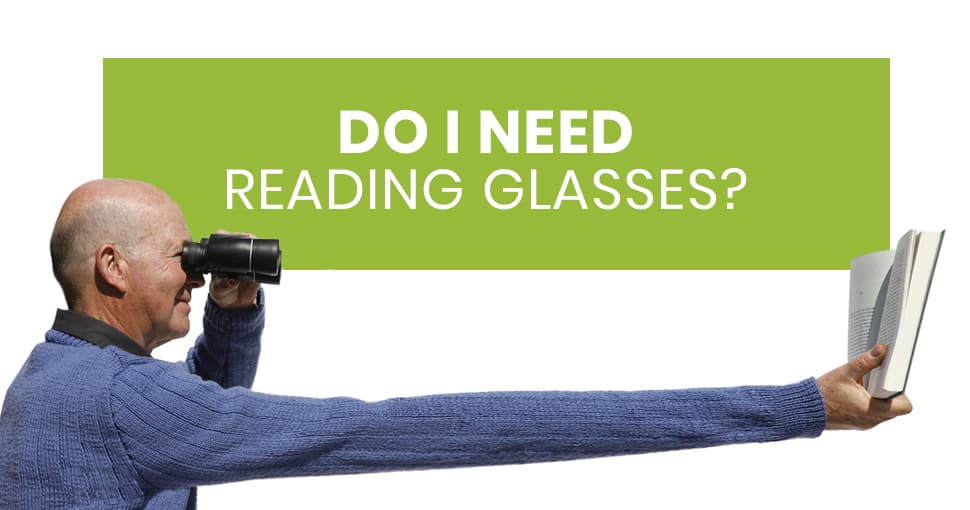Do I Need Reading Glasses?

If you suspect that you may need reading glasses, you are not alone. It is estimated that approximately 1 in 4 people require vision correction for presbyopia.

What is Presbyopia?
The natural lens in the front of the human eye helps keep vision in focus by filtering light to the retina at the back of the eye. Presbyopia occurs when the lens begins to stiffen and change shape as we age. Near vision is slowly impaired as this lens loses the elasticity that supports crisp, clear focus.
Top 10 Signs You May Have Presbyopia


1. You Have Celebrated the Big 4-0
According to the American Optometric Association, presbyopia is one of the most common vision issues for adults between 41 and 60.
2. Your Arms Suddenly Aren’t Long Enough
As presbyopia progresses, you may find yourself holding books, newspapers, or your phone further away from your face in order to see clearly. You may not even notice at first, but when you begin to use your full reach to hold your phone away from your face, it could be time for reading glasses.
3. Headaches Are Becoming a Frequent Pain
Eye strain from presbyopia can cause headaches. If you experience headaches after long periods of reading or computer work, ask your doctor if reading glasses could help.
4. You Have the Urge to Nap at Work
If you experience exhaustion after spending extended time reading or doing computer work, it could be an early sign of presbyopia. When the eye’s lens begins to change, the other parts of your vision system work hard to compensate and this can make you feel tired.
5. You Find Yourself Rubbing Your Eyes Frequently
This is another symptom that can be chalked up to eye strain. In the initial stages of presbyopia, your eyes may feel irritated from working to overcome focusing challenges. Frequent eye rubbing can cause dark undereye circles or bloodshot eyes.
6. Friends Have Nicknamed You Squint
Many people hold off on getting eyeglasses since presbyopia can progress slowly. However, if the people around you have noticed that you are often squinting when trying to focus, then it is time to see the eye doctor.
7. You Always Order “Your Regular” or “The Special” When Dining Out
Small print menus and low lighting in restaurants can make it difficult for people with near-vision loss to read through their options. People with presbyopia may find themselves ordering whatever their dining companion is having or whatever is on special just to avoid reading the menu.
8. You Have Upgraded the Wattage on All Your Light Bulbs
One of the symptoms of presbyopia is the need for brighter light in order to focus up-close. So if you are reaching for more and more light when reading, sewing, or working on other up-close hobbies, then it may be a sign you need vision correction for presbyopia.
9. You Have Unwillingly Scaled Back Your Makeup Routine
There is nothing wrong with barefaced beauty! But what happens when you want to wear makeup but you can’t focus well on up-close tasks like applying eyeliner? Talk to your eye doctor about presbyopia treatment options if you are a cosmetics lover who has started skimping on your makeup routine because vision gets in the way.
10. You See Halos
Circles of light can be pretty on holiday decorations, but not when they are impeding your vision while driving. If your vision blurs in a way that creates a halo-like effect around car headlights, street lights, or other objects, then it is time to check in with your eye doctor.




1 Fricke TR, Tahhan N, Resnikoff S, et al. Global Prevalence of Presbyopia and Vision Impairment from Uncorrected Presbyopia: Systematic Review, Meta-analysis, and Modelling. Ophthalmology. October 2018; 125 (10): 1492-1499
2 American Optometric Association. Adult Vision: 41 to 60 Years of Age. https://www.aoa.org/patients-and-public/good-vision-throughout-life/adult-vision-19-to-40-years-of-age/adult-vision-41-to-60-years-of-age Accessed August 19, 2019.




